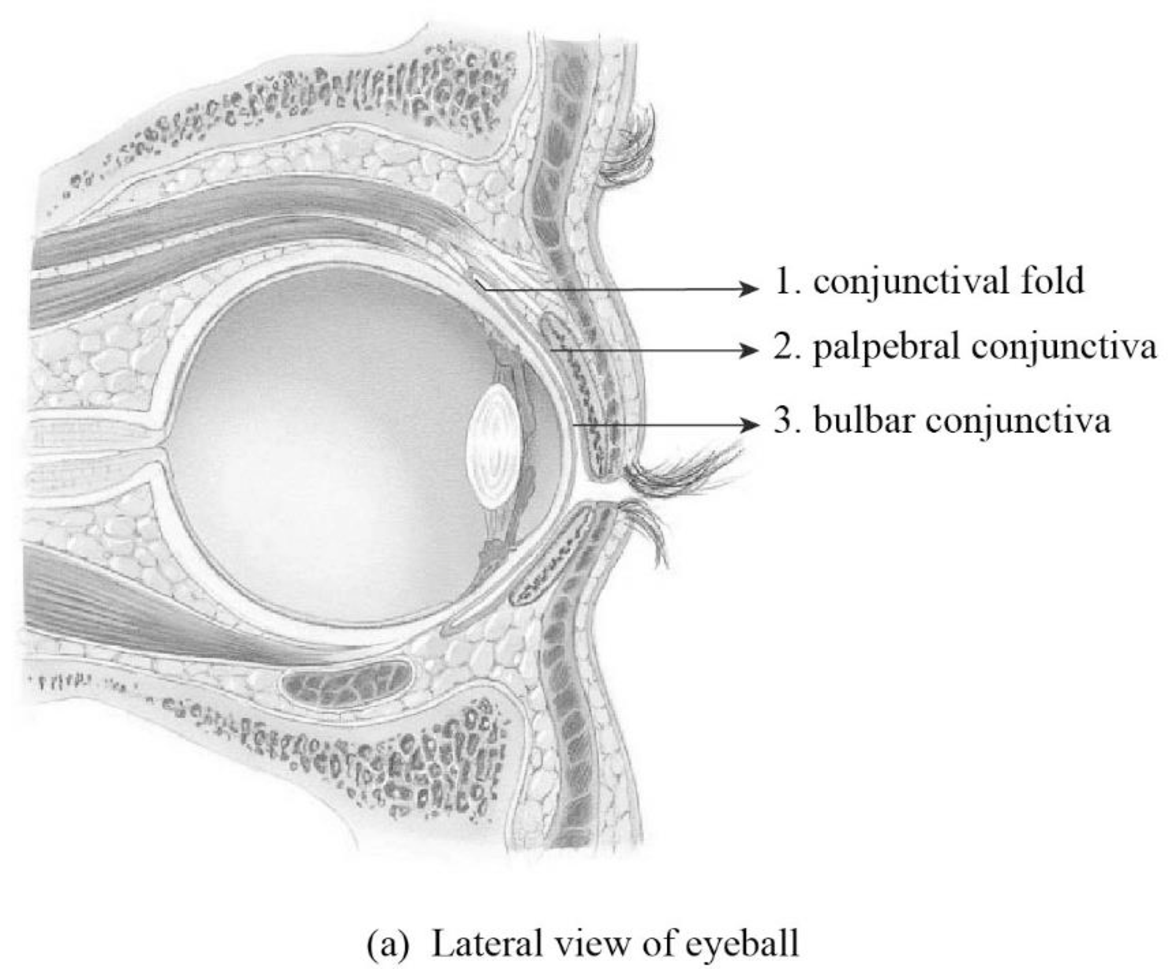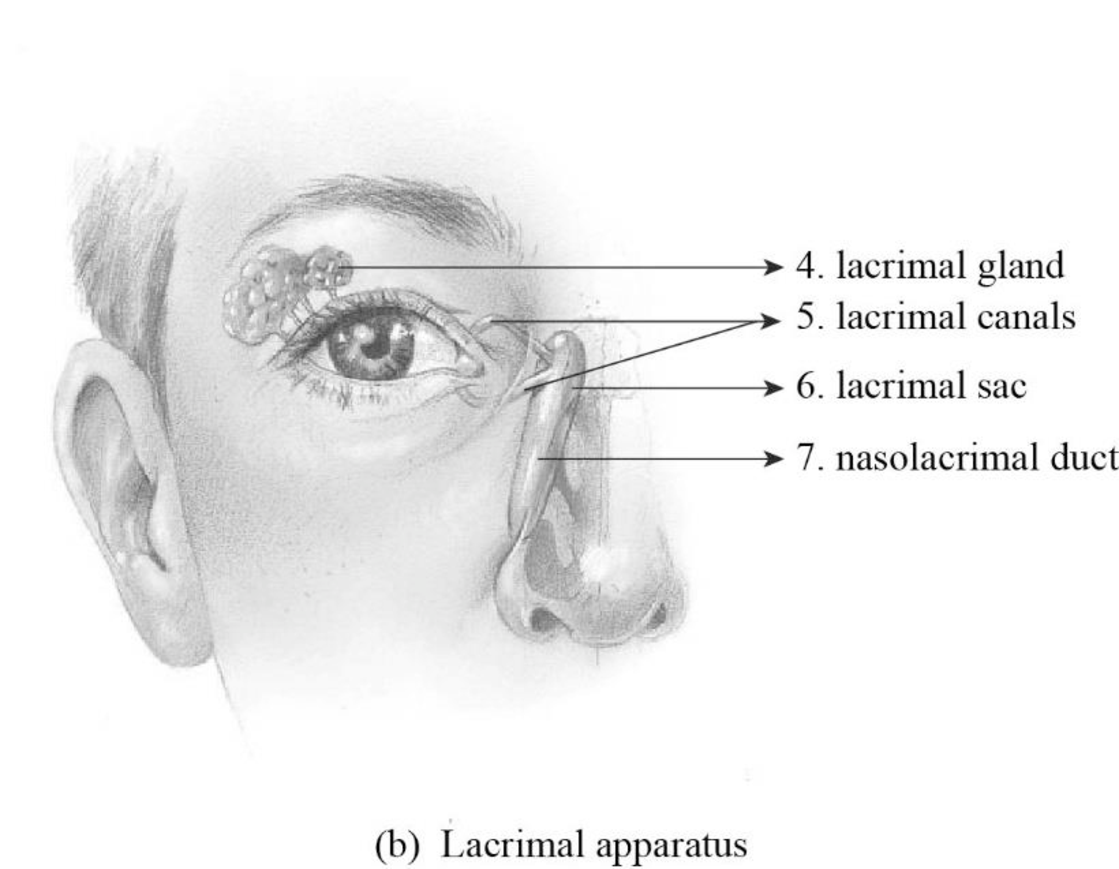
Concept explainers
To label: The parts of the conjunctive in Figure 24.1 (a).
Introduction: The eye of a human is a specialized organ. It has the ability to process and receive visual details. The light is detected by the eye and converted into
Answer to Problem 1.1BGL
Pictorial representation:

Fig1: The parts of conjunctiva
Explanation of Solution
1. Conjunctival fold: The conjunctiva is the mucous membrane. The eyelids’ inner surface and eyeballs’ exposed surface are lined by the conjunctiva. The pocket is formed by the conjunctival fold that possesses contacts from moving toward the eyeball’s posterior part.
2. Palpebral conjunctiva: The palpebral conjunctiva is the portion of the conjunctiva. The interior of the eyelid is covered by the palpebral conjunctiva.
3. Bulbar conjunctiva: The bulbar conjunctiva is otherwise referred to as ocular conjunctiva and it is a portion of the conjunctiva. The bulbar conjunctiva does not cover the cornea. It covers the anterior portion of the white of the eye.
To label: The structures of the lacrimal apparatus in Figure 24.1 (b).
Answer to Problem 1.1BGL
Pictorial representation:

Fig1: The structures of the lacrimal apparatus
Explanation of Solution
A group of structure involved in draining and generating tears is referred to as the lacrimal apparatus.
4. Lacrimal gland: The lacrimal gland secretes and generates tears onto the surface of the eye. The fluid is released continuously by the lacrimal gland, which protects and cleanses the surface of the eyes.
5. Lacrimal canals: They are small channels found in every eyelid and it is also called as lacrimal canaliculi. The tear is drained into the enlarged lacrimal sac from the eyes by the lacrimal canals.
6. Lacrimal sac: The dilated oval upper end of the nasolacrimal duct is lacrimal sac. The lacrimal sac is also referred to as lachrymal sac.
7. Nasolacrimal duct: The nasolacrimal duct is otherwise known as the tear duct. The tear is received by the enlarged nasolacrimal duct from the lacrimal sac and the tears are drained into the nasal cavity.
Want to see more full solutions like this?
Chapter 24 Solutions
Laboratory Manual for Anatomy and Physiology, 6e WileyPLUS (next generation) + Loose-leaf
- Where did this structure originate from? (Salix branch root) epidermis cortex endodermis pericycle vascular cylinderarrow_forwardIdentify the indicated tissue. (Tilia stem x.s.) parenchyma collenchyma sclerenchyma xylem phloem none of thesearrow_forwardIdentify the indicated structure. (Cucurbita stem l.s.) pit lenticel stomate tendril none of thesearrow_forward
- Identify the specific cell? (Zebrina leaf peel) vessel element sieve element companion cell tracheid guard cell subsidiary cell none of thesearrow_forwardWhat type of cells flank the opening on either side? (leaf x.s.) vessel elements sieve elements companion cells tracheids guard cells none of thesearrow_forwardWhat specific cell is indicated. (Cucurbita stem I.s.) vessel element sieve element O companion cell tracheid guard cell none of thesearrow_forward
- Respond to the following in a minimum of 175 words: How might CRISPR-Cas 9 be used in research or, eventually, therapeutically in patients? What are some potential ethical issues associated with using this technology? Do the advantages of using this technology outweigh the disadvantages (or vice versa)? Explain your position.arrow_forwardYou are studying the effect of directional selection on body height in three populations (graphs a, b, and c below). (a) What is the selection differential? Show your calculation. (2 pts) (b) Which population has the highest narrow sense heritability for height? Explain your answer. (2 pts) (c) If you examined the offspring in the next generation in each population, which population would have the highest mean height? Why? (2 pts) (a) Midoffspring height (average height of offspring) Short Short Short Short (c) Short (b) Short Tall Short Tall Short Short Tall Midparent height (average height of Mean of population = 65 inches Mean of breading parents = 70 inches Mean of population = 65 inches Mean of breading parents = 70 inches Mean of population = 65 inches Mean of breading parents = 70 inchesarrow_forwardP You are studying a population of 100 flowers that has two alleles at a locus for flower color, blue (B) and green (G). There are 15 individuals with the BB genotype, 70 individuals with the BG genotype, and 15 individuals with the GG genotype. (a) What are the allele frequencies of B and G in the starting population? Show your calculations. (2 pts) (b) Is this population in Hardy-Weinberg equilibrium? Show your calculations. (3 pts) 12pt v Paragraph BIU UA AV & VT2V f CO Varrow_forward
 Human Anatomy & Physiology (11th Edition)BiologyISBN:9780134580999Author:Elaine N. Marieb, Katja N. HoehnPublisher:PEARSON
Human Anatomy & Physiology (11th Edition)BiologyISBN:9780134580999Author:Elaine N. Marieb, Katja N. HoehnPublisher:PEARSON Biology 2eBiologyISBN:9781947172517Author:Matthew Douglas, Jung Choi, Mary Ann ClarkPublisher:OpenStax
Biology 2eBiologyISBN:9781947172517Author:Matthew Douglas, Jung Choi, Mary Ann ClarkPublisher:OpenStax Anatomy & PhysiologyBiologyISBN:9781259398629Author:McKinley, Michael P., O'loughlin, Valerie Dean, Bidle, Theresa StouterPublisher:Mcgraw Hill Education,
Anatomy & PhysiologyBiologyISBN:9781259398629Author:McKinley, Michael P., O'loughlin, Valerie Dean, Bidle, Theresa StouterPublisher:Mcgraw Hill Education, Molecular Biology of the Cell (Sixth Edition)BiologyISBN:9780815344322Author:Bruce Alberts, Alexander D. Johnson, Julian Lewis, David Morgan, Martin Raff, Keith Roberts, Peter WalterPublisher:W. W. Norton & Company
Molecular Biology of the Cell (Sixth Edition)BiologyISBN:9780815344322Author:Bruce Alberts, Alexander D. Johnson, Julian Lewis, David Morgan, Martin Raff, Keith Roberts, Peter WalterPublisher:W. W. Norton & Company Laboratory Manual For Human Anatomy & PhysiologyBiologyISBN:9781260159363Author:Martin, Terry R., Prentice-craver, CynthiaPublisher:McGraw-Hill Publishing Co.
Laboratory Manual For Human Anatomy & PhysiologyBiologyISBN:9781260159363Author:Martin, Terry R., Prentice-craver, CynthiaPublisher:McGraw-Hill Publishing Co. Inquiry Into Life (16th Edition)BiologyISBN:9781260231700Author:Sylvia S. Mader, Michael WindelspechtPublisher:McGraw Hill Education
Inquiry Into Life (16th Edition)BiologyISBN:9781260231700Author:Sylvia S. Mader, Michael WindelspechtPublisher:McGraw Hill Education





